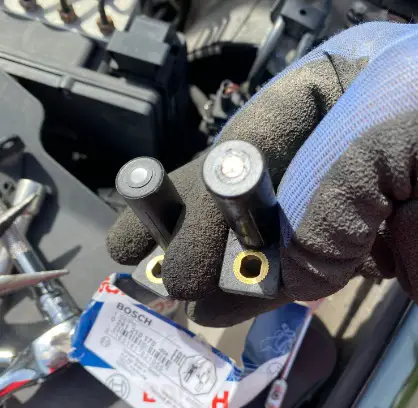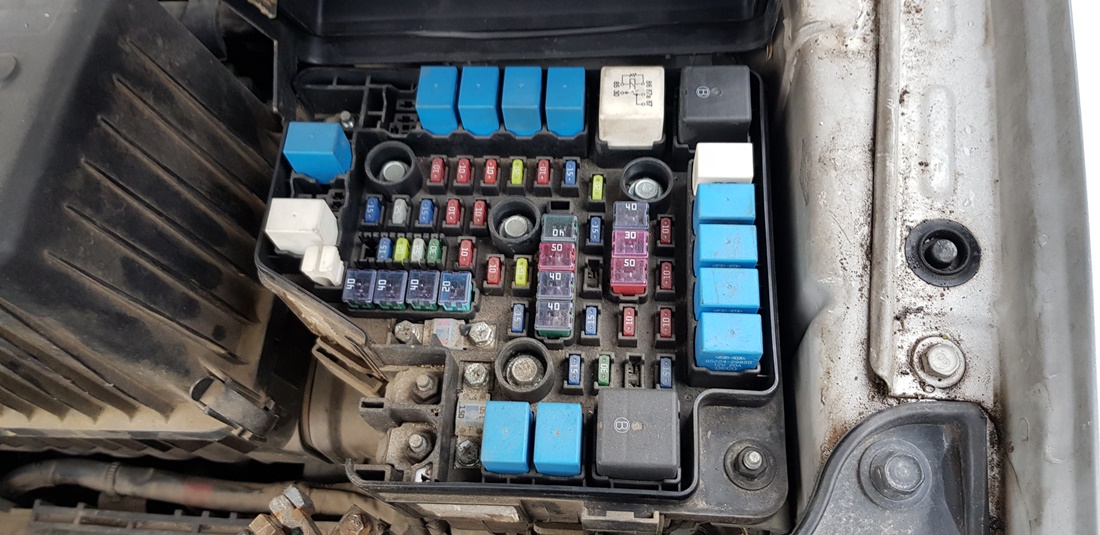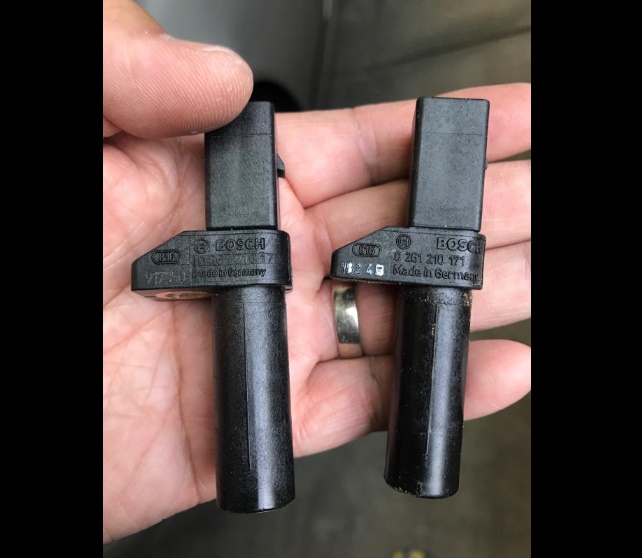If your transmission slips when first starting the car, it can be a very frustrating experience, especially if it happens frequently.
This is something that car owners do not want to experience because transmissions are quite expensive.
In this blog post, I will be discussing six possible causes of transmission slipping when starting your car.
By understanding the root of the problem, you can work on fixing it and restoring your peace of mind while driving!
Key Takeaway
- Transmission slip when first starting the car can be due to low transmission fluid, a clogged transmission filter, hardened clutch piston seals, a faulty solenoid, a bad torque converter, and worn-out clutch plates.
- To check the transmission fluid level, start your vehicle and let it run for a few minutes to warm up, then pull out the dipstick, wipe it clean, reinsert it fully, pull it out again, and check the fluid level against the marks on the dipstick.
- Continuing to drive a car with a slipping transmission is not recommended, as it can lead to further damage and potential safety issues.
Transmission Slips When First Starting The Car
![Transmission Slips When First Starting The Car [6 Possible Causes]](https://i0.wp.com/carcarehacks.com/wp-content/uploads/2022/11/Transmission-Slips-When-First-Starting-The-Car-6-Possible-Causes-1005x1024.jpg?resize=1005%2C1024&ssl=1)
Transmission slips when first starting the car can be due to a variety of reasons, including low transmission fluid, a clogged transmission filter, hardened clutch piston seals, worn or rounded out gears, and cold weather conditions.
1. Low transmission fluid level

Transmission fluid is a vital component of any vehicle with an automatic transmission. The fluid helps to lubricate the transmission, keeping it running smoothly. It also helps to cool the transmission, preventing overheating and premature wear.
The transmission could be slipping a gear when you first start your car due to a drain back issue where the fluid from the converter drains back into the bottom of the transmission. This would cause the converter to have to refill before it could engage gears correctly.
When the fluid level is low, it can cause the gears to slip or bind, making it difficult to shift into the correct gear. In addition, low fluid levels can cause the transmission to overheat, which can lead to serious damage.
If a car is low on transmission fluid, it may experience a variety of problems. The transmission may slip out of gear, or the gears may grind when shifting. The car may also hesitate when accelerating, or it may feel like it is “lugging” when climbing hills. In extreme cases, the transmission may even fail altogether.
Low transmission fluid levels can be caused by leaks, so it is important to have any leaks repaired as soon as possible. In addition, the transmission fluid should be checked regularly and topped off as needed to ensure that it remains at the proper level.
2. Clogged transmission filter

The transmission filter in a car is responsible for keeping the transmission fluid clean. The transmission fluid is what lubricates the gears in the transmission, and over time it can become contaminated with dirt, metal shavings, and other debris. If this debris is not removed, it can cause premature wear on the gears and eventually lead to failure.
The transmission filter is located between the fluid pump and the fluid reservoir, and it is typically made of paper or cloth. As the transmission fluid circulates through the filter, the debris is trapped and eventually removed when the filter is replaced. This simple device plays a crucial role in ensuring that the transmission fluid stays clean and effective.
Transmission fluid helps to keep the gears lubricated and cool, and it also helps to clean away any metal shavings that may be produced during the transmission process.
Over time, however, the filter can become clogged with debris, causing it to restrict the flow of the fluid. This can lead to transmission slipping, as the fluid is unable to properly lubricate the gears. In addition, the clogged filter can cause overheating, as it prevents proper ventilation.
If you notice your car’s transmission slipping, or if the temperature gauge is reading higher than usual, it’s important to have the filter replaced as soon as possible. Doing so will help to ensure that your car’s transmission continues to operate smoothly.
3. Hardened clutch piston seals
![Transmission Slips When First Starting The Car [6 Possible Causes]](https://i0.wp.com/carcarehacks.com/wp-content/uploads/2022/11/Transmission-Slips-When-First-Starting-The-Car-6-Possible-Causes-2-1024x550.jpg?resize=1024%2C550&ssl=1)
The clutch piston seals on an automatic transmission are one of the most important components in the transmission. The seals help to keep the transmission fluid in and the contaminants out.
Over time, however, the seals can become worn or damaged, allowing fluid to leak out and contaminants to enter the system. This can cause a variety of problems, including slipping gears when you first start the car, increased wear on the clutches, and eventually, complete failure of the transmission.
The old clutch piston seals that have lost their pliability allow ATF to bypass the clutch drum and prevent the clutch from engaging, which results in gear slipping when you first start your car.
If you have an automatic transmission, it’s important to check your clutch piston seals regularly. Over time, these seals can become worn out, causing your transmission to slip.
You can check for wear by removing the transmission pan and inspecting the seals. If they are cracked or damaged, they will need to be replaced. With a little bit of care and attention, you can keep your automatic transmission in good shape for years to come.
4. Faulty solenoid
![Transmission Slips When First Starting The Car [6 Possible Causes] 4](https://i0.wp.com/carcarehacks.com/wp-content/uploads/2022/11/Transmission-Slips-When-First-Starting-The-Car-6-Possible-Causes-4-1024x765.jpg?resize=1024%2C765&ssl=1)
An automatic transmission solenoid is a small, cylindrical device that helps to regulate the flow of transmission fluid.
The solenoid is attached to the transmission housing and contains a series of coils that create a magnetic field. This field helps to control the movement of a valve inside the transmission, which in turn regulates the flow of fluid.
The solenoid is controlled by the engine computer and is responsible for shifting gears, engaging and disengaging the clutch, and controlling the torque converter. Without a functioning solenoid, an automatic transmission would not be able to function properly.
When the solenoid becomes faulty, it can cause a variety of problems. For one, the transmission may not shift properly, or it may slip out of gear. Additionally, the fluid pressure may drop, causing the transmission to overheat.
If you suspect that your car’s automatic transmission solenoid is faulty, have it checked by a qualified mechanic. Left unchecked, a faulty solenoid can cause serious damage to your car’s transmission system.
5. Bad torque converter

The torque converter is a fluid coupling located between the engine and transmission that allows the engine to idle without fully engaging the transmission. It also acts as a buffer between the engine and transmission, absorbing any sudden changes in RPMs.
When you step on the gas pedal, the torque converter multiplies the engine’s torque, giving you a boost of power. Torque converters are only found on automatic transmissions, as they are not needed on manual transmissions.
The torque converter is an essential part of an automatic transmission. It helps to make driving more smooth and more comfortable.
A torque converter consists of a pump, turbine, and stator. The pump is connected to the engine and drives the turbine. The turbine is connected to the transmission and drives the stator. The stator is connected to the transmission and helps to circulate the fluid.
Transmission slipping occurs when the fluid in the torque converter becomes foamy and does not circulate properly.
This can be caused by a variety of factors, including a bad torque converter. When a torque converter is not working properly, it can cause the transmission to slip, resulting in reduced power and efficiency says RepairSmith.
6. Worn-out clutch plates

Clutch plates are an essential component of an automatic transmission. They are responsible for engaging and disengaging the transmission, as well as transferring the torque from the engine to the transmission. Without clutch plates, an automatic transmission would not be able to function properly.
There are typically two clutch plates in an automatic transmission: a high-gear clutch plate and a low-gear clutch plate. The high-gear clutch plate is responsible for engaging the transmission when the vehicle is in high gear.
The low-gear clutch plate is responsible for engaging the transmission when the vehicle is in low gear. When the vehicle is in neutral, both clutch plates are disengaged.
Clutch plates typically have a friction material bonded to their surface that helps to grip the transmission input shaft and prevent slippage. Over time, this friction material can wear down, causing the clutch plates to slip and eventually fail.
Over time, the friction surface of the clutch plates becomes smoother and eventually starts to slip. This can cause the engine to rev without the vehicle moving, or the vehicle to lunge forward when shifting into gear.
Why Does My Transmission Slip In First Gear?
If your car’s transmission is slipping in the first gear, it means that the transmission is not able to grip the engine’s power and convert it into motion. This can happen for a number of reasons, but the most common cause is low transmission fluid levels.
When the fluid level is low, the transmission cannot generate enough hydraulic pressure to engage the clutches. As a result, the transmission slips and the car loses power.
When the fluid starts to break down, it can cause the gears to grind and slip, resulting in a loss of power and efficiency. For this reason, it is important to change the transmission fluid on a regular basis. Most experts recommend changing the fluid every 30,000 miles or so, but it is always best to consult the owner’s manual for specific recommendations.
Another common cause of transmission slipping is wear and tear on the clutches. Over time, the clutch surfaces can become damaged or glazed, preventing them from gripping properly. If your transmission is slipping, it’s important to have it checked out by a professional as soon as possible.
Transmission problems can quickly lead to engine damage, so it’s best to nip them in the bud before they cause any further issues.
How To Check The Transmission Fluid Level
Checking the transmission fluid level involves locating the transmission dipstick, pulling it out, wiping it clean, reinserting it, pulling it out again, and then observing the fluid level markings on the dipstick.
Locate the Transmission Dipstick
The first step in checking your transmission fluid is to locate the transmission dipstick. This is usually located towards the back of an inline engine or to the side of a transverse engine. If you’re unsure where to find it, your vehicle’s owner’s manual can provide specific instructions.
Pull Out the Dipstick
Once you’ve located the dipstick, pull it out. Be careful not to spill any fluid that might be on the end of the dipstick.
Wipe the Dipstick Clean
Next, wipe the dipstick clean using a soft, lint-free cloth. This is necessary to get an accurate reading of the transmission fluid level.
Reinsert the Dipstick
After wiping the dipstick clean, reinsert it fully back into the transmission.
Pull Out the Dipstick Again
Pull the dipstick out again after you’ve fully reinserted it. This time, you’ll be able to accurately see the transmission fluid level.
Observe the Fluid Level
Finally, observe the fluid level on the dipstick. There are typically two markings on the dipstick indicating the ‘full’ level – one for when the engine is cold and one for when it is warm. The fluid should ideally be between these two markings. If it’s below the ‘cold’ mark, you may need to add more fluid.
Can Changing The Transmission Fluid Fix The Slipping Issue?
Changing the transmission fluid can potentially address the slipping issue if it’s caused by old, dirty, or low fluid.
As a mechanic, I have seen many cases where a simple transmission fluid change has solved the problem of slipping.
Over time, the transmission fluid can become contaminated with dirt and debris from the transmission itself.
This can interfere with the fluid’s ability to lubricate and cool the transmission, which can lead to slipping.
Additionally, if your transmission fluid is low, the transmission may not have enough fluid to function properly, which can also cause slipping.
However, it’s important to note that while changing the transmission fluid can sometimes fix the problem, it’s not a guaranteed solution for all cases of transmission slipping.
If the slipping is being caused by a more serious issue such as a worn clutch, damaged gears, or a faulty torque converter, changing the fluid won’t fix the problem and further mechanical repair will be required.
Should I Continue Driving My Car If The Transmission Slips?
Continuing to drive your car when the transmission slips is not advisable as it could lead to more severe damage to your vehicle.
Speaking from my experience as a mechanic, driving with a slipping transmission can potentially cause significant damage to your vehicle’s transmission system.
The transmission is a vital component of your vehicle, and if it’s not working properly, it can affect other parts of the vehicle as well. For example, a slipping transmission can cause more wear and tear on your engine, as it has to work harder to transmit power to the wheels.
Moreover, a slipping transmission can also be a safety issue. If your transmission slips while you’re driving, it could cause your vehicle to lose power or even stall, which could put you in a dangerous situation, especially if you’re driving at high speeds or in heavy traffic.
If you notice your transmission slipping, I’d recommend getting it checked out by a professional as soon as possible.
They can diagnose the cause of the problem and recommend the appropriate repairs. It’s always better to address these issues sooner rather than later to prevent more costly damage down the line.
FAQs
Q: What should I do if my transmission fluid level is low?
A: If your transmission fluid level is low, you should add the recommended type and amount of fluid as specified in your owner’s manual. Be careful not to overfill the transmission as it can lead to other issues. If the fluid level continues to drop over time, it may indicate a leak in the system, and it’s advised to have it inspected by a professional.
Q: Is a slipping transmission a sign of a serious problem?
A: A slipping transmission should never be ignored as it can be a sign of a serious problem. It’s important to address the issue promptly to prevent further damage to the transmission or other drivetrain components. Ignoring the problem can lead to costlier repairs down the line.
Q: Can a slipping transmission damage my car?
A: Yes, a slipping transmission can potentially cause damage to other components of your car. When the transmission slips, it generates excessive heat and friction, putting additional stress on the engine and drivetrain. This can lead to premature wear and damage if not addressed in a timely manner.
Q: How much does it cost to fix a slipping transmission?
A: The cost of fixing a slipping transmission can vary depending on the extent of the problem and the specific make and model of your car. Minor issues such as low fluid levels or a faulty solenoid can be relatively inexpensive to fix. However, if the slipping is due to more significant internal damage, it can be quite costly as it may require rebuilding or replacing the entire transmission.
Q: Can a slipping transmission be fixed without replacing it?
A: In some cases, a slipping transmission can be fixed without having to replace it entirely. If the issue is related to low fluid levels, a solenoid problem, or other minor malfunctions, it may be possible to repair the transmission without a complete replacement. However, it’s important to consult a professional to determine the best course of action based on your specific situation.
Q: How can I prevent my transmission from slipping when starting the car?
A: Regular maintenance and proper care can help prevent transmission slipping. Some tips to keep your transmission in good condition include: checking and maintaining proper fluid levels, using the manufacturer-recommended transmission fluid, avoiding excessive towing or hauling beyond your car’s capacity, and promptly addressing any signs of transmission trouble, such as slipping, odd noises, or leaks.
Conclusion and final thoughts
In conclusion, experiencing transmission slips when first starting your car can be a common and frustrating issue.
However, by understanding the potential causes and taking proper maintenance measures, you can prevent this problem from occurring.
Regularly checking and changing transmission fluid, keeping up with scheduled maintenance, and addressing any warning signs or issues promptly can help keep your car running smoothly.




